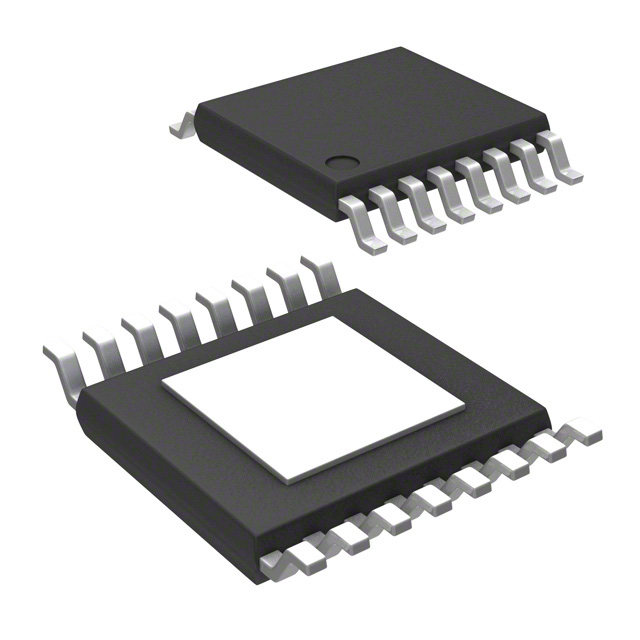TLV2475AIPWP
Product Overview
Category: Integrated Circuit (IC)
Use: TLV2475AIPWP is a quad operational amplifier designed for precision applications. It is commonly used in various electronic devices and circuits that require accurate signal amplification and processing.
Characteristics: - High precision: TLV2475AIPWP offers excellent accuracy and low offset voltage, making it suitable for applications where precise measurements are required. - Low noise: The IC has a low noise figure, ensuring minimal interference with the input signal. - Wide bandwidth: TLV2475AIPWP operates over a wide frequency range, allowing it to handle high-speed signals effectively. - Low power consumption: The IC is designed to consume minimal power, making it energy-efficient.
Package: TLV2475AIPWP comes in a small outline package (SOP) with a wide power pad (PWP) design. This package ensures easy integration into various circuit boards and provides efficient heat dissipation.
Essence: TLV2475AIPWP is built using advanced semiconductor technology, which enables it to deliver high performance and reliability in precision applications.
Packaging/Quantity: The IC is typically sold in reels or tubes, containing a specific quantity of units per package. The exact packaging and quantity may vary depending on the supplier.
Specifications
- Supply Voltage Range: 2.7V to 5.5V
- Input Offset Voltage: ±0.5mV (maximum)
- Input Bias Current: ±1pA (maximum)
- Gain Bandwidth Product: 10MHz
- Slew Rate: 6V/µs
- Operating Temperature Range: -40°C to +125°C
Detailed Pin Configuration
TLV2475AIPWP consists of four operational amplifiers, each with its own set of pins. The pin configuration is as follows:
- OUT1: Output of Operational Amplifier 1
- IN-1: Inverting Input of Operational Amplifier 1
- IN+1: Non-Inverting Input of Operational Amplifier 1
- VCC+: Positive Power Supply
- IN+2: Non-Inverting Input of Operational Amplifier 2
- IN-2: Inverting Input of Operational Amplifier 2
- OUT2: Output of Operational Amplifier 2
- GND: Ground
- OUT3: Output of Operational Amplifier 3
- IN-3: Inverting Input of Operational Amplifier 3
- IN+3: Non-Inverting Input of Operational Amplifier 3
- NC: No Connection
- IN+4: Non-Inverting Input of Operational Amplifier 4
- IN-4: Inverting Input of Operational Amplifier 4
- OUT4: Output of Operational Amplifier 4
- VCC-: Negative Power Supply
Functional Features
- High gain and accuracy: TLV2475AIPWP provides a high open-loop gain, ensuring precise amplification of input signals.
- Rail-to-rail output swing: The IC supports rail-to-rail output voltage swing, allowing it to handle signals close to the power supply rails.
- Unity-gain stable: TLV2475AIPWP remains stable even at unity gain, making it suitable for applications requiring a buffer or voltage follower configuration.
- EMI/RFI rejection: The IC exhibits excellent electromagnetic interference (EMI) and radio frequency interference (RFI) rejection, minimizing signal distortion.
Advantages and Disadvantages
Advantages: - High precision and accuracy - Low noise figure - Wide bandwidth - Low power consumption - Rail-to-rail output swing
Disadvantages: - Limited supply voltage range (2.7V to 5.5V) - Not suitable for high-voltage applications
Working Principles
TLV2475AIPWP operates based on the principles of operational amplifiers. It utilizes a differential input stage, followed by gain stages and output buffers. The IC amplifies the difference between the non-inverting and inverting inputs, providing an amplified output signal.
Detailed Application Field Plans
TLV2475AIPWP finds applications in various fields, including: 1. Precision measurement equipment 2. Audio amplification systems 3. Sensor signal conditioning 4. Data acquisition systems 5. Industrial control systems 6. Medical devices 7. Automotive electronics
Detailed and Complete Alternative Models
Some alternative models that can be considered as alternatives to TLV2475AIPWP are: 1. LM324: A quad operational amplifier with similar characteristics and performance. 2. AD8620: Precision operational amplifier offering low offset voltage and low noise. 3. MCP6004: Low-power quad operational amplifier with rail
قم بإدراج 10 أسئلة وإجابات شائعة تتعلق بتطبيق TLV2475AIPWP في الحلول التقنية
Sure! Here are 10 common questions and answers related to the application of TLV2475AIPWP:
Q: What is TLV2475AIPWP? A: TLV2475AIPWP is a quad operational amplifier (op-amp) with rail-to-rail input/output capability, commonly used in various technical solutions.
Q: What is the supply voltage range for TLV2475AIPWP? A: The supply voltage range for TLV2475AIPWP is typically between 2.7V and 5.5V.
Q: What is the maximum output current TLV2475AIPWP can provide? A: TLV2475AIPWP can provide a maximum output current of around 30mA.
Q: Can TLV2475AIPWP operate at high temperatures? A: Yes, TLV2475AIPWP has a wide operating temperature range of -40°C to 125°C, making it suitable for various environments.
Q: What is the typical gain bandwidth product of TLV2475AIPWP? A: The typical gain bandwidth product of TLV2475AIPWP is around 10 MHz.
Q: Is TLV2475AIPWP suitable for low-power applications? A: Yes, TLV2475AIPWP is designed for low-power operation, making it suitable for battery-powered or energy-efficient devices.
Q: Can TLV2475AIPWP be used in single-supply applications? A: Yes, TLV2475AIPWP is specifically designed for single-supply operation, allowing it to work with a wide range of voltages.
Q: Does TLV2475AIPWP have built-in protection features? A: Yes, TLV2475AIPWP has built-in features like short-circuit protection and thermal shutdown to ensure safe operation.
Q: What is the input offset voltage of TLV2475AIPWP? A: The input offset voltage of TLV2475AIPWP is typically around 1 mV.
Q: Can TLV2475AIPWP be used in audio applications? A: Yes, TLV2475AIPWP can be used in audio applications due to its low distortion and wide bandwidth characteristics.
Please note that these answers are general and may vary depending on specific datasheet specifications or application requirements.


